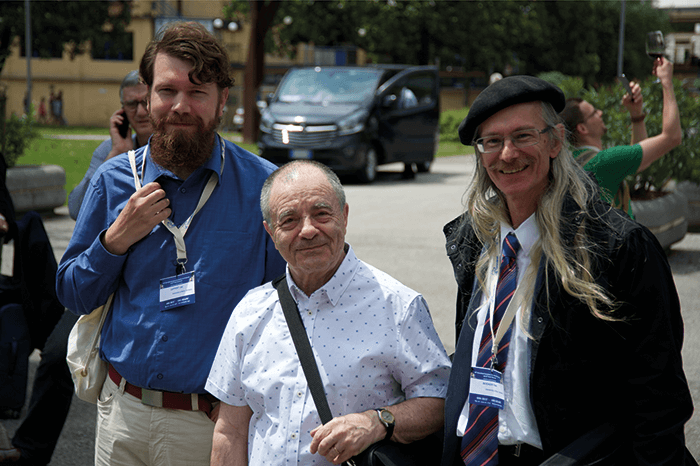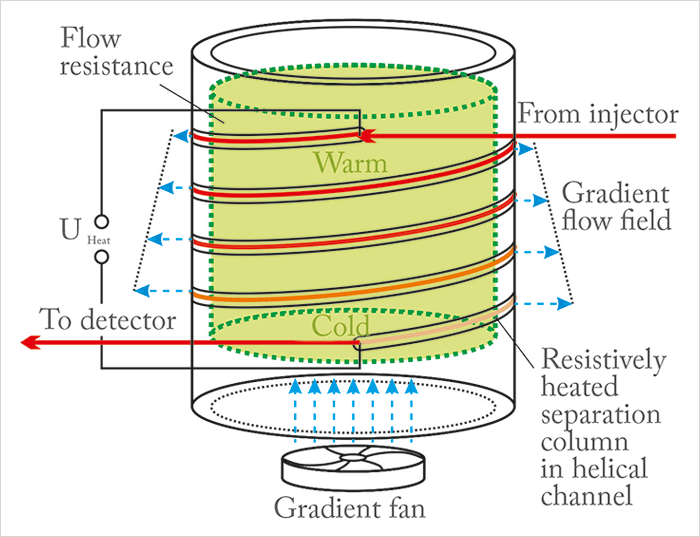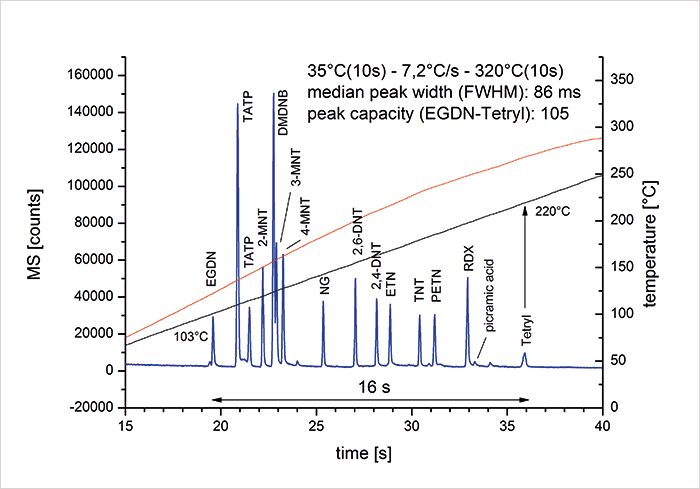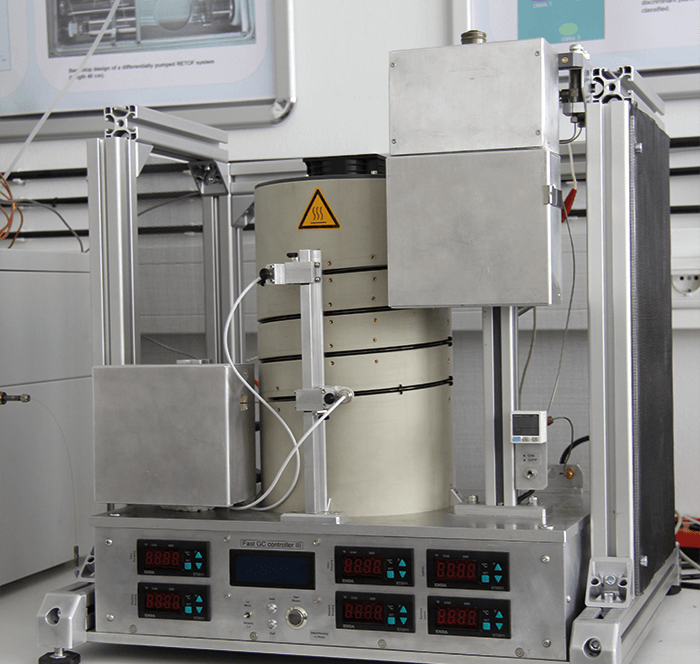For a long time, my field of research has focused on electronic nose systems, gas sensors and odor measurements. And it was with this background that I jumped into more analytical approaches, including GC-TOF-MS, during the course of a security research project. As always, I had written some pretty ambitious objectives into the proposal, with the aim of gaining the interest of the reviewers. In this particular case, I included the development of a fast GC system for near real-time explosives detection. Not too unrealistic, I thought – admittedly, without too much real experience in this particular field... Nevertheless, we were eager to please and full of ideas; we are always desperate to gain such funding because the research group consists of only two scientists, me and Jan Leppert – both essentially scientific freelancers without permanent positions. Indeed, we swing from one project to the next like Tarzan moving through the forest on unlikely lianas (to use an image from my childhood films). Unfortunately, unlike Tarzan, we are always in danger of missing the next one!

Luckily, we got access to the funding and started the tough task of thinking about how we would fulfill expectations. Jan had attended the 2010 Riva conference (ISCC and GCxGC symposia), where he heard a lecture by Aviv Amirav on a fast GC, based on resistive heating of a stainless steel capillary that was coaxial to the standard separation column.
Learning the ropes
Around the same time the funding came in, a physicist approached us for a diploma thesis and I thought that it would be a good opportunity to learn more about the thermal conditions of resistively heated capillaries. In this experimental work, we learned a great deal about heat loss due to natural convection and radiation heat loss, in addition to gaining a first-hand experience of the problems encountered when measuring the temperatures of tiny structures! We saw huge differences in the temperatures between vertical- and horizontal-oriented capillaries and between lower and upper coils, respectively. We surmised that attaining uniform temperatures using the concept of resistive heating may be an irresolvable problem. At one point, we briefly discussed the idea of using a fan inside a heated coil, but I stopped the discussion dead with the killer argument that we would create even worse conditions with forced convection and turbulence. Also around the same time, we had trouble with a variable splitter in a GC-olfactometry set-up. The split ratio between the MS and sniffing port changed drastically during the temperature program. We worked hard on the theory of this splitter type and later on a Deans’ switch to find a solution. Eventually, we published this work in two papers and during the review process one reviewer recommended additional references. I opened the journal archives to download the references and – by chance – at the bottom of the screen a 2013 paper caught my eye: “Dynamic thermal gradient gas chromatography” by Jesse Contreras, Milton Lee and colleagues (1). I immediately associated thermal gradients with cold spots and therefore thought the paper would cover such gradients – and how to avoid them – in great detail. But when reading this excellent paper, I became more and more excited. The idea of peak focusing on a thermal gradient was so obvious and convincing. Looking back, I was very naïve, but at the time I thought the effect should catapult GC resolution to unlimited heights! There was only one problem: realization.Paper trail
I started to collect all available papers on the subject. The first idea dates back to Russian scientists in the 1950s, with contributions from Zhukhovitsky and Turkel’taub (2). In those Cold War times, the concept had remained isolated in the East, with publications only in Russian and written in Cyrillic. Not until 1968 did Rudolf Kaiser (who had worked in East Germany before coming to the West) published a German paper on the subject (3). I also found some patents for short packed column arrangements that had been filed by Siemens in the late 1960s. Unfortunately, it seemed that the thermal gradient idea had not been applied to longer capillary columns. I also considered the later work of Rubey and Jain & Phillips from the 1990s, but they were ‘proof-of-principle’ set-ups – very promising but complicated to realize (4), (5). The challenge sparked my engineering and physics ambitions. How could I design a simple TG-GC using standard capillaries and no cryogenic gases that was as easy to use as a conventional GC? At the beginning, the very idea seemed akin to squaring the circle. Imagine the challenge: apply a very smooth thermal gradient along a capillary of 2 meter or even more – without cold spots and in a controlled and programmable manner up to temperatures of 400 °C.Inspiration strikes
Sitting on the backseat of a car on a long journey armed with only a pencil and a sheet of paper, I entered a state of creative nirvana and suddenly came up with an idea. Shame on me for rejecting forced convection! Dissipated heat in a long capillary cannot be controlled, but the corresponding heat loss through forced convection can. And that change of mindset shifted the construction problem from gradient heat generation to a fluid mechanics task of a controlled flow across the capillary. When I arrived home, I immediately studied engineering text books on heat transfer. The calculation of heat transfer from tubes is a very old area of engineering science. Even the designers of steam engines needed such knowledge. Therefore an excellent and proven theory existed, making it possible to calculate the energy balance of a heated capillary under forced convection conditions. When I looked at the results, it was clear that I had the key to building a thermal gradient GC! More than a hundred degree Celsius difference was easily achievable with moderate flows of ambient air. After a few more long car journeys and some experimental trials with other concepts, the final and very simple realization of the flow field thermal gradient GC was born. The heated column is mounted in a helical channel in the wall of a tube. Inside the tube, a porous material, which is used to form flow resistance, creates a very smooth flow field. As a result, the forced flow on the resistively heated column continuously decreases from one end of the column to the other. See Figure 1 for an illustration of the concept.
With the help of excellent staff at the workshop of our Institute of Agricultural Engineering – namely the electronic engineer Roland Lutz and the precision mechanic Wilfried Berchtold – we have now built several prototypes of the instrument. It took more than two years from the final idea to the measurement performance we have now acquired. To come back to the idea of naivety and lack of knowledge, I suspect that we would have never started this project if we had known in advance how much detailed work was necessary and how much missing knowledge we had to acquire – a true drawback of being a newcomer! Indeed, the basic idea needed countless additional ‘micro inventions’ until it performed well. Since those early days, we have performed many measurements with the system, especially in the main application field for which it was built: the near real-time detection of explosives. But the concept has a special advantage for basic research. We are capable to perform measurements with and without the thermal gradient – just by switching the gradient fan off. We have found that the gradient does indeed have advantages; it improves the peak sharpness but, perhaps more importantly, reduces elution temperatures. Our findings are very robust and can be explained using theoretical considerations.

Getting deeper
Now some words on ‘deeper knowledge.’ The outstanding Leonid Blumberg published papers in the 1990s on the topic of gradients in gas chromatography (and recently also in liquid chromatography). He very clearly deduces that thermal gradients, in theory, are of no benefit. We cannot be better than the ‘ideal basic separation’ (6). It is somewhat like the Carnot principle of GC and I refer to it as ‘Blumberg’s theorem.’ Thankfully, I did not read (or understand) these papers at the beginning of our project. If I had, once again, we probably wouldn’t have got started. So the big question: is Blumbergs’s theorem a contradiction to our experimental results? Maybe not. Theory – and theoretical modeling – usually require a reduction of the complexity of the system under evaluation. During our work on very fast GC, we have seen that many of the published theories are not valid for our system and sometimes have guided our efforts in the wrong direction. GC not only comprises the transport of the analytes but also the processes at the head of the column. The FF-TG-GC shows a very strong focusing effect because we can start the temperature program near ambient temperatures. I suspect that the remobilization effect plays an important role and is maybe not sufficiently accounted for in the theory and models of GC. We now have the very nice task of filling the gap between theory and experimental findings. For us, the interplay between experimental results and theoretical considerations is always the most fruitful way to gain a deeper understanding. In 2015, we finally published our first paper – “Flow Field Thermal Gradient GC” – in Analytical Chemistry (7); I thank the reviewers for their benevolence. Unfortunately, after publication the paper seemed to disappear in the silence (or noise?) of the ever-expanding publication universe...
A new hope, a new community
One night, I received a newsletter from The Analytical Scientist magazine that showcased the content from the November 2015 issue. A diligent reader, I looked at the topics and “Landmark literature 2015” caught my eye. I was curious to see what was recommended by my peers and all of a sudden suffered an unexpected adrenaline rush! Pat Sandra’s title – “Go with the flow (field)” – surely could only refer to our paper? I am still grateful to Pat Sandra for his very friendly and completely unexpected appreciation of our work. My first attendance at the ISCC conference in Riva del Garda this year closed the circle after Jan’s first attendance in 2010. From numerous papers, I knew many of the speakers by name but not in person. It was a great experience to come into contact with so many chromatographers whose work has been inspirational, setting the benchmark for our efforts. To name only a few directly connected to thermal gradient GC, I was able to talk with Rudolf Kaiser, Milton Lee and his co-workers, and had first discussions with Leonid Blumberg. And I was pleased that my own presentation received a friendly reception that led to other new contacts and further inspiration. I felt like I was finally arriving in a new and exciting community!The next chapter
OK. So we have developed a new and powerful tool for hyper-fast GC – but who needs it? Is sample preparation not always the time limiting step? What about the sample capacity of micro bore capillaries? Is such a system as stable and reliable as a state-of-the-art GC? These are just a few of the questions that people raise when it comes to their concerns about fast GC. My guess is that their experiences with previous systems on the market were not too encouraging. But either way, resistance against change is strong.The reality is that we have only explored but one percent of the parameter space of TG-GC. Our two-person workgroup is unable to do much more than technical development and a few basic measurements, which is why many more questions are left open than answered – and also why so few applications have been developed thus far. Nevertheless, our expectations of the new basic technology are high. On our agenda: the application of a gradient column as a second dimension in GCxGC and the construction of a comprehensive heart-cutting GC to obtain very high peak capacity within a very short cycle time. Maybe that’s naïve again. But I hope that efficient low thermal mass fast GCs will have a promising future in gas chromatography!
Peter Boeker is a research associate at the Institute of Agricultural Engineering, University of Bonn, Germany.
References
- JA Contreras et al, “Dynamic thermal gradient gas chromatography”, J Chromatogr A, 1302, 143-51 (2013). DOI: 10.1016/j.chroma.2013.06.008. AA Zhukhovitsky, “Some developments in gas chromatography in the U.S.S.R”., in: R.P.W. Scott (Ed.), Gas chromatography 1960: Proceedings of the third symposium on gas chromatography, Edinburgh 8–10 June 1960, Butterworths, London, 1960, pp. 293–300. R Kaiser, “Temperatur-gradienten-chromatographie teil 1: reversions-gas-chromatographie”, Chromatographia 1, 199–207 (1968). DOI:10.1007/BF02255480 WA Rubey, “Operational theory and instrumental implementation of the thermal gradient programmed gas chromatography (TGPGC) mode of analysis”, J High Resol Chromatogr, 15, 795–799 (1992). DOI: 10.1002/jhrc.1240151205 V Jain and JB Phillips, “High-speed gas chromatography using simultaneous temperature gradients in both time and distance along narrow-bore capillary columns”, J Chromatogr Sci 33, 601–605 (1995). DOI: 10.1093/chromsci/33.11.601 LM Blumberg, “Outline of a theory of focusing in linear chromatography”, Anal Chem, 64, 2459–2460 (1992). DOI: 10.1021/ac00044a028 P Boeker and J Leppert, “Flow Field Thermal Gradient Gas Chromatography”, Anal Chem, 87 (17), 9033–9041 (2015). DOI: 10.1021/acs.analchem.5b02227




